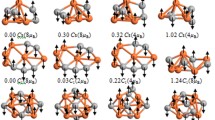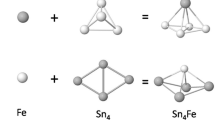Abstract
Density functional theory-based electronic structure calculations are carried out to obtain the geometries corresponding to the lowest three energy values for Tey (y = 2 − 20) clusters. A comparison of the stability from binding energy curve of these clusters with exchange-correlation energy functional approximated within the local density approximation (LDA), generalized gradient approximation (GGA) and hybrid functional (PBE0) indicates the structures to be most stable within the LDA, and these results are also found to be closer to those obtained from the experiments. A transition from two-dimensional to three-dimensional structures is observed at y = 5. Clusters form arm-chair and crown-like structures for small sizes and ring-like geometries for larger sizes. Partial charge density and eigenvalue spectrum reveal that there is no s-p hybridization and the highest occupied states are mostly π non-bonding orbitals. Clusters with even number of atoms show a charge distribution approximately uniformly localized around each atom similar to the σs anti-bonding orbital in Te2. Comparative study of the structural and electronic properties of small Tey clusters (y = 2 − 8), with corresponding isoelectronic sulphur and selenium clusters, predicts sulphur clusters to be most stable and Te clusters to be least stable. Bond lengths increase while bond angles decrease in going from S → Se → Te but the shapes of the geometric structures are more or less the same. Following the work of Ghosh et al. (J Phys Chem C 112:983–989, 2008) on Te helical structures and Pal et al. (Sci Rep 3:2051-1-7, 2013) on Se helical chains, we have carried out spin-polarized electronic structure calculations for helical chains of Tey (y = 3 − 8). Interestingly, we have found that Te helical chains also reveal a behaviour similar to that predicted for Se chains by Pal et al.












Similar content being viewed by others
References
Adamo C, Barone V (1999) Toward reliable density functional methods without adjustable parameters: the PBE0 mode. J Chem Phys 110:6158–70. https://doi.org/10.1063/1.478522
Akola J, Jones RO (2012) Structure and dynamics in amorphous tellurium and Ten clusters: a density functional study. Phys Rev B 85:134103–1-12. https://doi.org/10.1103/PhysRevB.85.134103
Barlow DA, Alvarez PK (2005) Theoretical study of Te5 rings. Mol Phys 103:643–46. https://doi.org/10.1080/00268970412331327769
Becker J, Rademann K, Hensel F (1991a) Electronic structure of selenium- and tellurium-clusters. Z Phys D 19:233– 235
Becker J, Rademann K, Hensel F (1991b) Generation of intense selenium and tellurium cluster beams. Z Phys Chem 173:21–35
Benamar A, Rayane D, Melinion P, Tolibollet B, Broyer M (1991) Comparison between selenium and tellurium clusters. Z Phys D 19:237–239
Blöchl PE (1994) Projector augmented-wave method. Phys Rev B 50:17953–17979
Bréchignac C, Cahuzac Ph, de Frutos M, Garnier P, Kebaili N (1995) Dissociation energies of tellurium cluster ions from thermoevaporation experiments. J Chem Phys 103:6631–6636. https://doi.org/10.1063/1.470392
Ceperley DM, Alder BJ (1980) Ground state of the electron gas by a stochastic method. Phys Rev Lett 45:566–569
Demkov AA, Sankey OF (2001) Theory of zeolite supralattices: Se in zeolite Linde type A. J Phys: Condens Matter 13:10433–57. stacks.iop.org/JPhysCM/13/10433
Ernzerhof M, Scuseria GE (1999) Assessment of the Perdew–Burke–Ernzerhof exchange-correlation functional. J Chem Phys 110:5029–5036. https://doi.org/10.1063/1.478401
Ghanty TK, Ghosh SK (1996) A density functional approach to hardness, polarizability, and valency of molecules in chemical reactions. J Phys Chem 100:12295–12298
Ghosh P, Bhattacharjee J, Waghmare U (2008) The origin of stability of helical structure of tellurium. J Phys Chem C 112:983–989. https://doi.org/10.1021/jp077070d
Giannozzi P, Baroni S, Bonini N, Calandra M, Car R, Cavazzoni C, Ceresoli D, Chiarotti GL, Cococcioni M, Dabo I, Corso AD, de Gironcoli S, Fabris S, Fratesi G, Gebauer R, Gerstmann U, Gougoussis C, Kokalj A, Lazzeri M, Martin-Samos L, Marzari N, Mauri F, Mazzarello R, Paolini S, Pasquarello A, Paulatto L, Sbraccia C, Scandolo S, Sclauzero G, Seitsonen AP, Smogunov A, Umari P, Wentzcovitch RM (2009) QUANTUM ESPRESSO: a modular and open-source software project for quantum simulations of materials. J Phys: Condens Matter 21:395502–1-19. https://doi.org/10.1088/0953-8984/21/39/395502
Heinemann C, Koch W (1997) The tellurium dimer and its anion. Mol Phys 92:463–470. https://doi.org/10.1080/002689797170202
Hoareau A, Cabaud B, Uzan R (1978) Properties of small aggregates of group VI elements (S, Se, Te). Evidence for metallic character of tellurium aggregates. J Physique Lett 39:303–305
Hohenberg P, Kohn W (1964) Inhomogeneous electron gas. Phys Rev 136:B864–871
Hohl D, Jones RO, Car R, Parrinello M (1987) The structure of selenium clusters—Se3 to Se8. Chem Phys Lett 139:540–545
Hohl D, Jones RO, Car R, Parrinello M (1988) Structure of sulfur clusters using simulated annealing: S2 to S13. J Chem Phys 89:6823–6835. https://doi.org/10.1063/1.455356
Jalochowski M, Mikolajczak P, Subotowicz M (1972) Measurements of the work function and the fermi level in thin tellurium films. Phys Stat Sol (a) 14:K135–K137
Kittel C (2005) Introduction to solid state physics. Wiley, Hoboken, p 50
Kohn W, Sham LJ (1965) Self-consistent equations including exchange and correlation effects. Phys Rev 140:A1133– 1138
Kresse G, Furthmüller J (1996a) Efficiency of ab-initio total energy calculations for metals and semiconductors using a plane-wave basis set. Comput Mater Sci 6:15–50
Kresse G, Furthmüller J (1996b) Efficient iterative schemes for ab initio total-energy calculations using a plane-wave basis set. Phys Rev B 54:11169–11186
Martin RM (2004) Electronic structure, basic theory and practical methods. Cambridge University Press, Cambridge, pp 119–229
Nagaya K, Oohata A, Yamamoto I, Yao M (2002) Photoelectron spectroscopy of small tellurium clusters. J Non-Cryst Solids 312-314:337–340
Pal A, Shirodkar SN, Gohil S, Ghosh S, Waghmare UV, Ayyub P (2013) Multiferroic behavior in elemental selenium below 40K: effect of electronic topology. Sci Rep 3:2051–1-7. https://doi.org/10.1038/srep02051
Pan BC (2002) Geometric structures, electronic properties, and vibrational frequencies of small tellurium clusters. Phys Rev B 65:85407–1-8. https://doi.org/10.1103/PhysRevB.65.085407
Perdew J, Zunger A (1981) Self-interaction correction to density-functional approximations for many-electron systems. Phys Rev B 23:5048–5079
Perdew JP, Burke K, Ernzerhof M (1996) Generalized gradient approximation made simple. Phys Rev Lett 77:3865–3868
Radzig AA, Smirnov BM (1985) Reference data on atoms, molecules and ions. Springer, Berlin
Rong QMS, Liu FM, Li XY, Zhao YF, Jing XG (2007) Ab initio study of small coinage metal telluride clusters Au,nTem (n, m = 1, 2). Chem Pap 1:308–312. https://doi.org/10.2478/s11696-007-0038-z
Teter MP, Payne MC, Allan DC (1989) Solution of Schrödinger’s equation for large systems. Phys Rev B 40:12255–12263
Verges J, Effantin C, Babaky O, d’Incan J, Prosser SJ, Barrow RF (1982) The laser induced fluorescence spectrum of Te2 studied by fourier transform spectrometry. Phys Scr 25:338–350
Woo D, Choi S, Han D, Kang H, Park S (2001) Nanosized tellurium clusters grown at thiolated β-cyclodextrin molecular template modified electrodes: electrochemical deposition and STM characterization. Phys Chem Chem Phys 3:3382–3386. https://doi.org/10.1039/b100985k
Acknowledgments
The authors acknowledge DST FIST and DST PURSE grants for providing the computing facility.
Funding
This study was financially supported by the Nanomission initiative of the Department of Science & Technology, Government of India, New Delhi (DST/NM/NS-15/2011(G)).
Author information
Authors and Affiliations
Corresponding author
Ethics declarations
Conflict of interest
The authors declare that they have no conflict of interest.
Electronic supplementary material
Below is the link to the electronic supplementary material.
Rights and permissions
About this article
Cite this article
Ghemud, V.S., Gol, H.A.S. & Kshirsagar, A. How different are Te clusters—a first-principles study. J Nanopart Res 20, 177 (2018). https://doi.org/10.1007/s11051-018-4274-7
Received:
Accepted:
Published:
DOI: https://doi.org/10.1007/s11051-018-4274-7




